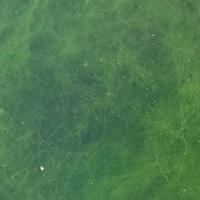Not all algal blooms are harmful. Algal blooms caused by cyanobacteria are concerning because they are capable of producing toxins that can be harmful, even lethal, to humans, livestock and pets. Non-harmful algae and other aquatic plants can also be found in many ponds or lakes, and may have excessive growth like cyanobacteria. Although these may be a nuisance, they are not likely to cause health concerns.
So how do you know if a bloom is harmful or not? Higher levels of toxins are typically associated with algae blooms that appear as thick foam or scum on the water’s surface. The photo gallery below shows examples of aquatic plants and algae that are not cyanobacteria.
Unfortunately, you cannot tell if an algal bloom is harmful or not just by looking at it. If you come across areas of thick algae, take precaution by avoiding water contact and keeping pets out of the water. You can always contact a professional by completing the Harmful Algal Bloom Reporting Form. A member of the Missouri HAB Response Team will be glad to assist you in determining whether you should be concerned about the bloom. For general information about harmful algal blooms, visit the department's Harmful Algal Blooms (HABs) webpage.







